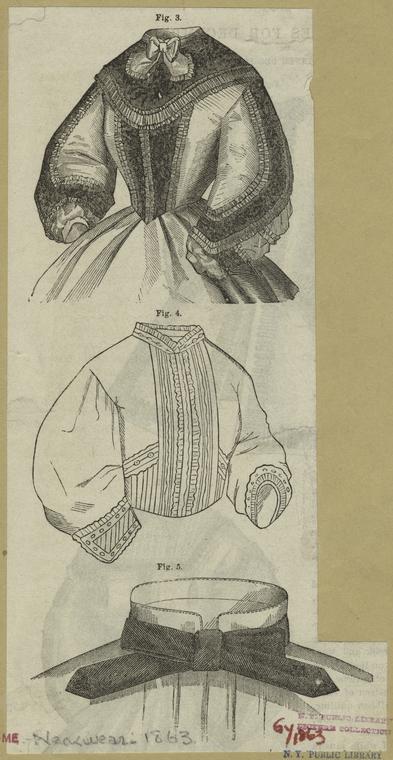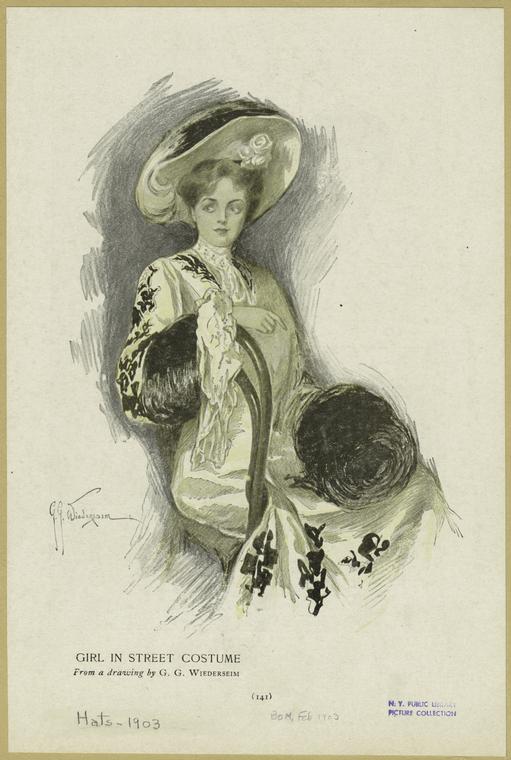Blog Archive
In Vogue: a quick history of the Garment Industry and the Lower East Side

Two styles of dress collars from 1863, hours hand work for the lace and stitching. Image courtesy of the NYPL.
September can be the herald of a fresh beginning. For students, September brings the start of a new school year, for Jews, it brings the New Year, and for the sartorially inclined, it brings a flurry of fresh fashion fodder and furious Instagramming all for New York Fashion Week.
As we speak, the most current possible “looks” are on display from New York designers (and one very famous French house). The debates will rage about what the youthfulness or seriousness of the clothing means about the economy, though most of the consumers for this apparel are of the stratosphere of wealth that is unaffected by even major fluctuations. Comments will be made about the age and shape and ethnic background of the models, who are usually young and thin and Caucasian. Almost none of the hubbub has anything to do with our little Tenement on the Lower East Side, except the final debate about how much of the clothing is actually made in the United States and, more specifically, made in New York. While Fashion Week has little to do with the history of the Lower East Side it has everything to do with the garment industry in New York and how it has changed.

A luxe style from 1903, manufacturers were beginning to operate factories across the city. Image courtesy of the NYPL.
This week’s shows feature clothes for the spring season 2016. This practice harkens back to the days when clothing was made by hand, and elaborate outfits for wealthy customers were agreed upon several months in advance so that they would be complete by the time the customer wanted to wear the apparel. Many of the residents of the Tenement at 97 Orchard Street worked in the garment industry, assembling clothing in their own home or in a neighboring apartment. Most of these families were not making ‘couture’ garments made to order; instead, they had agreements with “manufacturers” who contracted a set number of garments a week. The Levine family, who lived in the Tenement in the late 1800s, would have pooled their resources to buy a single sewing machine, manned by the Harris Levine, the patriarch. They produced garments in their home factory and sent the items off to the manufacturers when finished. The manufacturers would in turn sell them to department stores like Ridley’s, where middle class and wealthier clients would buy the “ready made” items. Many department stores, would also employ seamstresses and tailors to alter garments to fit more closely to the customer.

Looks from 1913, the attire was becoming simpler for the wearing and for the producer. Image courtesy of the NYPL.
But by the early 1900s manufacturers decided to consolidate their production in larger factories throughout the city. A family living in the Tenement during this time period would have sent their daughters to work in this factory outside of the home, to do less skilled labor and more receptive mechanized work.

The Great Depression reaches nearly to the ankles... Today's cheap manufacturing overseas allows customers the freedom to buy new clothing not just every season but every couple of weeks. This scheme too has its drawbacks for low-paid laborers and for the environment. Image courtesy of the NYPL.
Today, even some of the most avant-garde clothing in the New York shows is produced outside of New York as the cost of labor has risen with pressure from labor unions and government regulation. Some New York designers, like the bright young label Public School, make it a point of pride to create their clothing in the five boroughs for authenticity and quality. So if you tune into the shows, you are tuning in to the next chapter of garment manufacturing in New York… and by next season the clothing will be history.
Posted by Julia Berick Marketing and Communications Coordinator